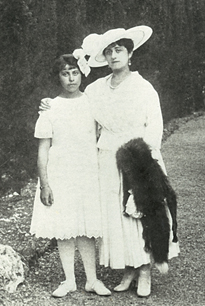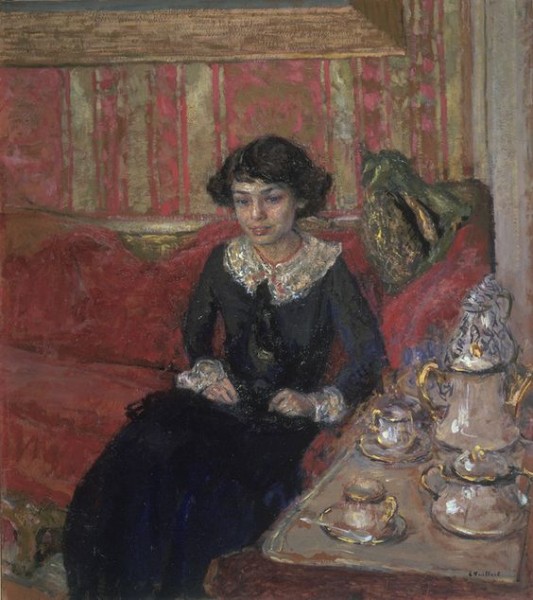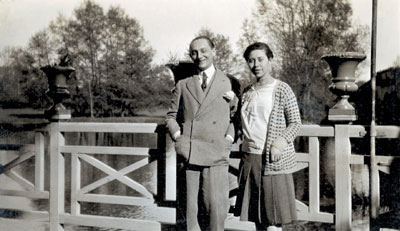Irène Némirovsky would live in troubled times. Born in Kiev in 1903, into a family of Jewish bankers, Irina Nemirovsky was only two years’ old when pogroms swept the Ukraine. With an Orthodox cross hurriedly placed around her neck, the little girl was hidden behind a bed by the family cook. She came to no harm and wealth and elegance surrounded her early years, the first provided by her father, Leon, one of the richest financiers in Russia, the second by her mother, Anna, a narcissistic beauty, who preferred to be known as Fanny, and had her birth certificate altered, taking twelve years off her age.

For love she depended on her adored French governess, Zézelle, Mademoiselle Rose, who moved with the family in 1914 to St Petersburg, where Leon found himself ever closer to the seat of power. By 1917 that was no longer a good place to be. Zézelle committed suicide, drowning herself in the river Neva. The Némirovskys moved to Moscow, before fleeing by sledge to Finland, then Sweden, and in 1919 to France. By 1920 they were living in Paris, in the smart 16e arrondissement, 18 avenue du Président Wilson. They were back in society. Irène was seventeen. She enrolled at the Sorbonne, immersed herself in Russian and French literature, joining the jeunesse dorée of Paris. In 1923 her father rented a furnished flat for her, not far from the family home, and beside the poet and novelist Henri de Régnier.
It was time for the twenty-year-old Irène Némirovsky (no longer Irina, and by now with added accents) to launch herself in literary circles. Her first short story had been published in 1921, and many more would follow before and after the novel which made her name. David Golder was published to great critical acclaim in 1929, followed by Le Bal in 1930. Both novels were made into films. The first premièred in 1931 at the Elysée Gaumont, on the Champs Elysées, with in the audience among others Colette, Maurice Ravel, and the writer Paul Morand, the second starring the (very) young Danielle Darieux. Literary and financial success seemed assured. But there were clouds on the horizon. In September 1932 Léon died in Nice, leaving very little money – he had been ruined by the swindler Kreuger. Four months later in January 1933 Adolf Hitler was appointed Chancellor of Germany. Irène’s husband Michel Epstein (they had married in 1926) worked for a bank, but they had an expensive lifestyle and, though short stories published in periodicals with wide circulations might for a while fill the financial hole in the Epstein household, politics was against them, more so than they could possibly know.
Readers of Dimanche and Other Stories can’t escape the harsh irony of knowing more than the author, knowing that the economic troubles that are hinted at in several stories will turn to economic disaster, that attempts to flee the Occupation ( ‘Le spectateur’ and ‘Monsieur Rose’) will fail, and that anti-Semitism (tentatively treated in ‘Fraternité’) will gather unimaginable momentum. Michel and Irène were not blind to what was happening. They made several attempts at naturalisation, all of which were turned down, before getting themselves and their two daughters baptised into the Catholic Church in 1939 by a friendly priest, a move which served them no better than it served countless others. It did not protect from the effects of the Statut des Juifs, published on 3rd October 1940, excluding Jews from work in the public sector and from most major professions: Michel lost his job in the bank. On 4th October the first Otto list removed from sale works by political refugees, Jewish authors and other expressing anti-German views. Three days later Michel and Irène had no alternative but to register as Jews. They had already left Paris and joined their daughters in Issy-l’Evêque, a village in Burgundy, where they were to remain, first in the Hôtel des Voyageurs, and later in a generously proportioned house in the centre of the village.

Irène Némirovsky’s name was not on the first Otto list, and some, but not all, of her publishers continued to be as supportive as they were able. Horace de Carbuccia, in particular, a notorious anti-Semite, a Pétainiste, who was tried after the war for collaboration but acquitted, continued to publish her work until February 1942, eventually under a pseudonym, in his periodical Gringoire. A second Otto list appeared on 8th July 1942. Once again Irène Némirovsky’s name was not included, but a footnote extended the list to include ‘all books written by Jewish authors’. She was arrested in Issy l’Evêque five days later.
Such was the background against which the stories in this collection were written, but the bigger picture hardly features. World events may have formed her characters, brought them together and, though they might not recognise it determined their actions, but they were more caught up in themselves and in each other than in world events. Wild cat financial ventures, losses on the international stock exchange, a ministerial scandal trigger a family crisis, or an engagement. A Parisian aesthete’s attachment to his collections charts the German advance: the porcelain is moved to a safe place after the Anschluss in 1938, the glassware and pictures after the fall of Prague, the books and silver shortly before Munich. News of a forthcoming sale of antique ivory coinciding with reports of the Nazi-Soviet pact, confirms another’s decision to return to his native America.

Némirovsky’s stories are about individuals, or small groups of people, mothers and daughters, mothers and sons (fathers are mostly absent, distant or dead), siblings, casual acquaintances. All, even the most minor characters, have their ‘back stories’, of which history is but one element. In their 2010 biography Philipponat and Lienhardt quote Némirovsky, ‘I never make a plan. I begin by describing for my own purposes the physical appearance and a full biography of all the characters, even the less important ones. In this way, even before getting down to the actual writing itself, I know my characters perfectly, even, it seems to me, down to the way they speak; I know how they will behave, not just in the book but throughout their lives. When this is done, I begin to write.’ According to Myriam Anissimov author of the preface to the Folio edition of Suite Française, once every detail was in place, she would take up a red and and a blue pencil, highlighting those she considered essential, which might amount to no more than a few lines.
The title story, ‘Dimanche’, is one of (unspoken) generational misunderstandings between Agnès and her twenty-year-old daughter, Nadine. They are central to the narrative, such as it is, but they are not the only clearly delineated characters. Agnès looks back on an unhappy marriage to an unfaithful husband, her recollections like a series of lantern slides. Her in-laws flash up: ‘She thought of his family, her hateful mother-in-law, the noise his sisters made in their miserable, gloomy drawing-room.’ We feel confident that she could tell us more about Guillaume’s loud and overbearing sisters, and much, much more about his mother – widowed, we guess, doting on an only son, unwelcoming and disapproving of Agnès, unwilling or unable to improve on the cheerless furnishing. We are given few facts about the maid, Mariette, but, told that she goes to meet her lover at the station ‘clutching her Sunday imitation pigskin bag in her large bare hands’, we can picture her whole cheap outfit, sense her nervous excitement, and make more conjectures – do those hands belong to a country girl, are they red with overwork, is she the only servant? And we worry for Nadine’s plain friend, Arlette, with her tortoiseshell spectacles, and her green car (the colour is a brilliantly superfluous detail), an appendage which makes her most attractive to the others in their set.

Agnès and Nadine, and Guillaume, tell their own stories in inner monologues, which hide as much as they reveal. Némirovsky does not intervene. Beyond limited stage directions and brief casting suggestions there is little authorial presence in any of her short stories. Most rely on monologue or dialogue. ‘Liens du sang’ in particular reads like a play. A disputatious family gathering turns into a death bed vigil during which unsettled sibling scores are briefly forgotten only to resurface when the patient recovers. Like actors in rehearsal given a few incidental details to build on, we learn that the wife of the eldest son is the grand-daughter of a famous surgeon, that the wives of the younger brothers are sisters, daughters of a lowly insurance clerk, spent summer holidays in a mock Swiss chalet ‘with a pointed roof, a wooden balcony and the name written above the door in shells and pebbles.’ Anna Demestre has been a fickle mother, favouring one child and then another, only to find herself in old age clumsily ‘trying to make them closer to one another, trying to wipe out the misunderstandings and rivalries between them’; she was a difficult mother-in-law to her sons’ young brides. Now, with the confidence of age, her daughters-in-law, who once feared her disapproval, ‘took a particular, rather cruel, pleasure in seeming to defer to her and to appear loving … but within the affectionately tolerant way they looked at her, there remained a repressed animosity and a longing for revenge.’ Némirovsky’s rare interventions in the narrative are telling and she is brilliant on family relationships. The action takes place over little more than two days and is brilliantly paced, capturing both the stress and the tedium, ‘the overwhelming tiredness that overcomes members of the same family when they have been together for more than an hour.’Augustin and his sister Mariette crack nuts in their hands ‘with identical gestures’. It could be Chekhov.
When Augustin Demestre stops for coffee on his way home after a long night, Némirovsky specifies that it is at the Régence, not a telling detail but somehow enriching. One feels she knows the name of the waiter who served him, and possibly of the regulars at the neighbouring tables. But there is no commanding authorial voice in ‘Liens du sang’, nor in other stories, and in several it is altogether absent. Though small this is an extraordinarily varied collection, and perhaps the one unifying characteristic is the lack of a ‘reliable narrator’. In ‘Le sortilège’, the only story with a Ukrainian setting, the opening paragraph is, we assume, a frank admission by the ‘writer’ that ‘what seemed simple was in fact masked by secrets and shadows …’. The challenge to the reader is to find a way through the shadows, to spot the clues and to rearrange the evidence as it is presented by the ‘child’.

Children make useful unreliable narrators, the innocent eye reporting on a situation that is far from innocent. So too do letter writers, especially when the writer is a servant, who may have an axe to grind. Clémence (La femme de don Juan) is an elderly maid, who may or may not be dying and wants to put the record straight, or hurt, or save from embarrassment, or perhaps blackmail, the daughter of her erstwhile employer. We see the family only through the eyes of Clémence, and must decide how far to trust her as she, very gradually, unveils the secrets behind the Tragedy that beset the Family – the capital letters are hers. Her tone is sometimes cloying, presuming on an intimacy with the young Monique, and often openly unpleasant, full of innuendos, some possibly innocent, others not so. Her unease is inadvertently exposed from time to time as she shifts from slow deliberate phrasing to short staccato sentences: ‘So Madame goes up to her room and rings for me to get her coat. I bring her good vicuna coat. It was still raining and there was very little light. I help her get dressed and she pulls on a little purple felt hat’. Such lovely realist details: we ask what else was on Némirovsky’s ‘long list’ for Madame’s wardrobe? The Tragedy was Madame’s, but Clémence has taken ownership of the story, and of the truth. Camille the eponymous confidante of the title does something similar in ‘La confidante’, but ultimately, in a brilliant final twist, less successfully. We can never be sure, Némirovsky reminds us, dealing the trump card, why one person loves in another,
Contemporary reviewers praised Irène Némirovsky for her lack of sentimentality, which they considered along with the ‘energy, sobriety, density, force, narrative organisation, style and construction’ to be untypical of a woman author. Assuming that ‘density’ refers to the richness of the content, and ‘sobriety’ means ‘restraint’, it seems beyond argument that this astonishingly varied collection of stories demonstrates all of these qualities, and does so in a way which are in fact precisely typical of the best women authors, with a focus on the domestic and emotional detail, on the shades beneath the surface.
